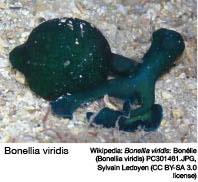

 One of the interesting things that you
can see in nature is how different the males are from the females. In
some cases males are larger than females, usually for protection
purposes. In other cases the females may be larger and may actually be
more dominant. When you start studying small animals you find
remarkable exceptions.
One of the interesting things that you
can see in nature is how different the males are from the females. In
some cases males are larger than females, usually for protection
purposes. In other cases the females may be larger and may actually be
more dominant. When you start studying small animals you find
remarkable exceptions.
On the ocean floor there is an organism called the green spoonworm (Bonellia viridis) where the male is
200,000 times smaller than its mate. He spends his life inside the
female’s reproductive tract and regurgitates sperm through his mouth to
fertilize the female’s eggs. When they were first discovered,
scientists thought the male was a parasite.
How the males come into existence is another one of those things which
are so remarkable it is hard to believe. A green spoonworm larva has no
sex when it hatches. It becomes a male or a female depending upon what
it encounters during its first three weeks of life. If the larva
encounters a female, it turns into a male and takes its position in the
female’s reproductive tract. If it does not find a female, it turns
into a female itself. Its sex is determined by environmental factors
rather than genetic factors (chromosomes) as in most creatures.
God has designed life with a wide variety of methods of propagating
itself. All living things have a great capacity to produce offspring,
and that is why we continue to have life on the planet. The green
spoonworm lives in crevices on the ocean floor, and having a mate in
her body makes reproduction easy and prolific. Being at the bottom of
the food chain, this provides for an ecosystem that needs a wide base
of food sources. As we learn more about how ecosystems function, we see
a wonder-working hand has gone before and provides in remarkable ways
for all living things.
Source: Seed magazine 2009,
and
http://en.wikipedia.org/w/index.php?title=Bonellia_viridis&oldid=396808901
Back to
Contents
Does God Exist?, MayJun11.



 One of the interesting things that you
can see in nature is how different the males are from the females. In
some cases males are larger than females, usually for protection
purposes. In other cases the females may be larger and may actually be
more dominant. When you start studying small animals you find
remarkable exceptions.
One of the interesting things that you
can see in nature is how different the males are from the females. In
some cases males are larger than females, usually for protection
purposes. In other cases the females may be larger and may actually be
more dominant. When you start studying small animals you find
remarkable exceptions.